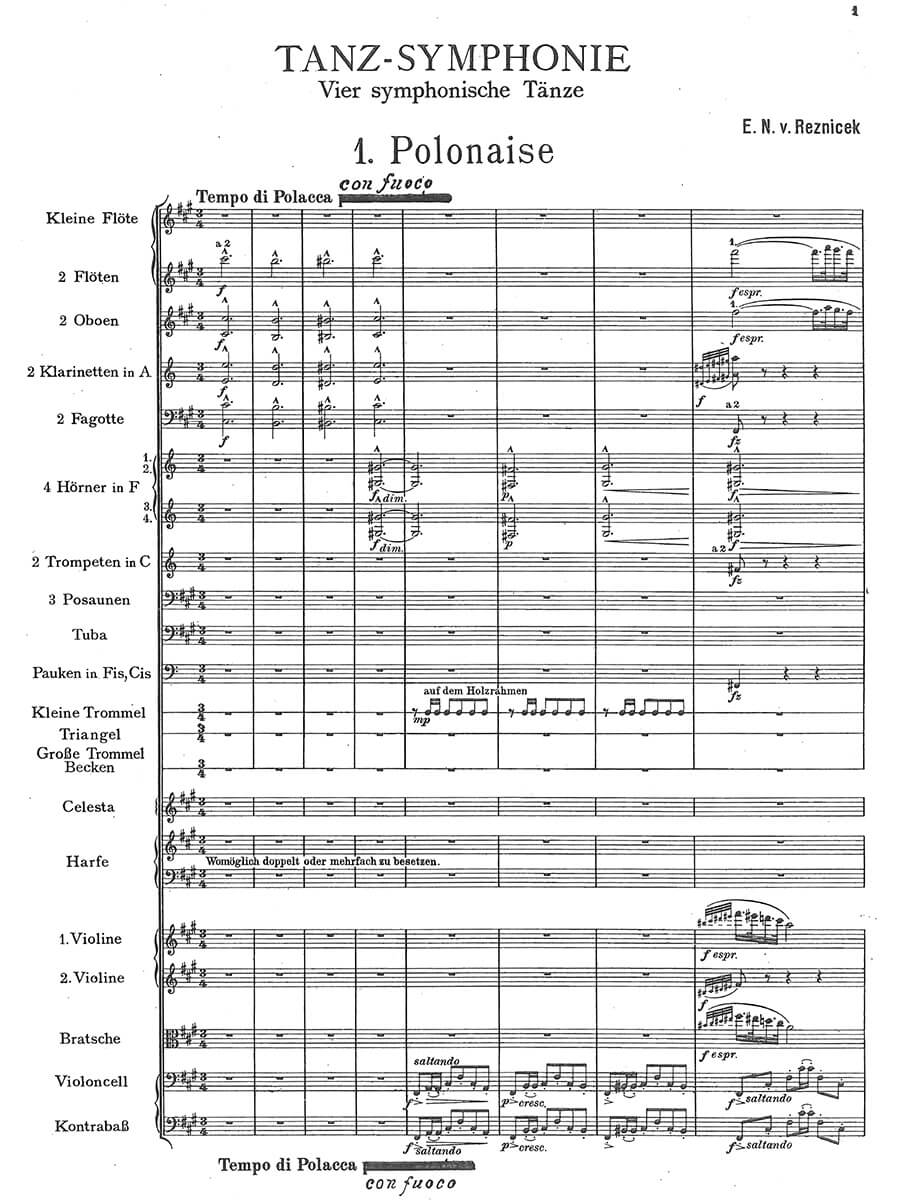V. Symphony f-minor „Dance-Symphony“
Reznicek, Emil Nikolaus von
31,00 €
Emil Nikolaus von Reznicek
(b. Vienna, 4 May 1860 – d. Berlin, 2 August 1945)
V. Symphony f-minor „Dance-Symphony“
(1924)
Preface
Emil Nikolaus von Reznicek came from a Bohemian officers’ family. Already at an early age he began to compose. Already Johannes Brahms noticed the young talent, however initially Reznicek began legal studies in Graz. But at the same time, he continued musical studies. After Reznicek, probably on purpose, failed the first law exam, he went to study at the famous Leipzig Conservatory. There he studied composition under Carl Reinecke. His career as a musician however started initially as a conductor. After many positions as Kapellmeister in Zurich, Stettin, Jena, Bochum, Berlin, Mainz he finally stayed for a longer period in Prague. With the first performance of his opera Donna Diana he at last achieved the long awaited break through as a composer. Then followed the position as Kapellmeister in Mannheim. Due to his for that period scandalous lifestyle – he lived openly with a not yet divorced woman (his later seconds wife Berta) – he lost this position. In 1905 the family moved to Berlin. He celebrated his next great success in 1920 with his opera Knight Bluebeard. Along with Richard Strauss and Hans Pfitzner he was considered as one of the leading composers of the Weimar Republic. His luck was not to last very long. Following the assumption of power by the National Socialists in 1933 the family situation changed. His wife Berta was of Jewish descent which Reznicek never concealed. His son however became a Party member and even joined the SA. This led to a break between father and son. His wife even tried to commit suicide. Reznicek daughter Felicitas on the other hand joined the Resistance at an early stage and was a British agent during the war. In spite of his work for the „Permanent Council for International Cooperation of Composers“ his moms, written in 1941, were not freed by the Ministry of Propaganda. 1943 he flees from the ever-increasing bomb attacks on Berlin to Baden near Vienna. The Rosenberg Department, responsible for culture, seized all his manuscripts after his departure and stored them in a min in the Lausitz. Up to now some of them remain missing. On the 24th of December 1943 Reznicek suffers a stroke and required nursing care. At the beginning of 1945 he was brought to Bad Saarow, in order to enter the sanatorium there. But on arrival, the Wehrmacht had already changed it to an army hospital. Via circuitous routes he arrived in his Berlin flat where he died shortly afterwards on the 2nd of August 1945 of hunger typhoid.
In his music his experience as a conductor is often evident. His instrumentation does not need to hide itself behind that of his friend Richard Strauss. He generally keeps to the usual orchestration. Characteristic for him however is his pleasure in the unexpected and the original. Therefor his compositions are not so easy to understand as the orchestra works of his famous friend R. Strauss. Reznicek composed five important symphonies as well as his successful operas. But these did not follow the development of the symphonic of Bruckner or Mahler, as the audience expected. Unfortunately, his symphonies have almost been forgotten. Thus Manuel Gervinik does not mention in his dissertation „The symphony in Germany and Austria in the period between the two World Wars“ the contributions of Reznicek to this genre at all. Only in recent years have the orchestra works of Reznicek gained a little attention again through recordings. The fifth and last symphony is the extensive Dance Symphony. Reznicek’s great talent for the humorously dancing but also for the ambivalent is particularly apparent in this work. After completion in 1924 he first called the composition „Four symphonic dances “. This shows clearly that it is not really a symphony in the strict sense of the word, but that the form is rather that of a suite. Formally one could compare it with Edvard Grieg’s Symphonic Dances. there the Csadas replaces an expressive quiet movement, and the Ländler replaces the Scherzo within the symphonic structure. During the printing in 1926 it was renamed Dance Symphony. The first performance took place in Vienna on the 31st of October 1926 under the direction of Felix Weingartner. It was performed by the Vienna Philharmoniker. In 1927 there followed scenic danced performances under the title Puppets of Death in Dresden, and Erich Kleiber conducted the work 1933 in New York.
Duration: with cuts about 41 minutes, without cuts about 52 minutes.
Translation: John Conrad
For performance material please contact Birnbach, Lochham. Reprint of a copy from the collection Marcus Prieser, Wittmund.
| Score No. | |
|---|---|
| Edition | |
| Genre | |
| Size | |
| Printing | |
| Pages |
